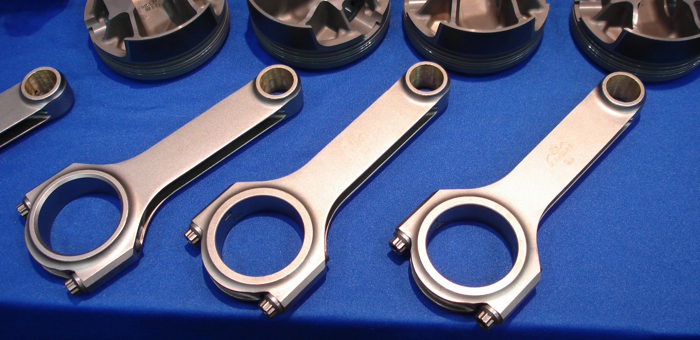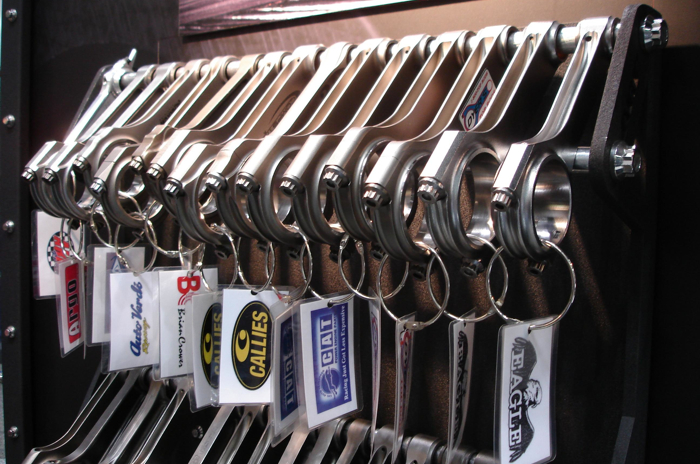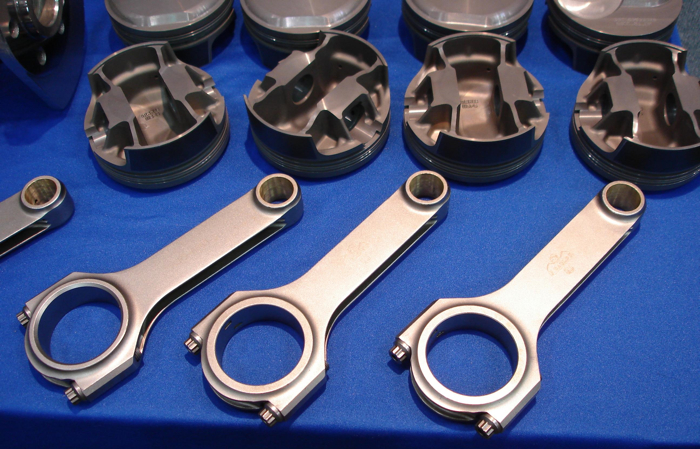Choosing a set of connecting rods is one of the critical steps in a performance engine build. The rods have to be strong enough to handle the anticipated speeds and loads, but also affordable for customers who have a limited budget.
Most stock rods in late model engines can safely handle 400 to 500 horsepower. Beyond that, you’re looking at upgrading to some type of performance rod. They could be aftermarket powder metal rods (yes, they do make stronger PM rods that can handle up to 700 hp), forged steel rods, billet steel rods, aluminum rods (forged or billet) or even titanium rods. There are a lot of options as well as a lot of myths about which types of rods you should and shouldn’t use.
Let’s start with OEM style powder metal rods. PM rods have been around since the 1970s and are now used in most gasoline production engines as well as many diesel engines. The car makers like powder metal rods because the rods are nearly as strong as many forged rods (about 80 to 90 percent of the tensile strength depending on the alloy and rod dimensions), yet require much less machining because the closed die hot forging process that is used to squeeze and sinter the metal powder into shape produces a rod that is very close to its final dimensions. Consequently, it takes much less machining and less cost to finish the rod. The weights of PM rods are typically heavier than those of comparable forged rods, but they are also closer to each other (within a couple of grams) and more consistent than that of many OEM forged rods.
In the 1990s, a process for “cracking” off rod caps was invented that reduced manufacturing costs of PM rods even more. Instead of cutting and machining the rod caps, the rod is held in a press that fractures and breaks off the end cap. This eliminates the need to cut off the cap and machine the cap and rod mating surfaces and bolt holes. The cracked cap only fits one way and allows near perfect alignment between the rod and cap. This also reduces the risk of cap movement that could cause the cap to loosen over time. The only downside of cracking the cap is that PM rods cannot be easily reconditioned by grinding down the rod and cap mating surfaces if the big end bore is worn out-of-round. You have to throw the rod away and replace it with a new one.
Powder Metal Myths
One of the myths about powder metal rods is that they’re no good for performance. If that were true, you wouldn’t see PM rods in current production high output GM LS and LT1 engines, Ford Modular and Coyote engines, Chrysler Hemi engines and numerous other high output engines (such as light truck diesel engines).
Powder metal rods can handle all kinds of driving while lasting several hundred thousand miles. Of course, that’s with “normal” engine speeds and loads (no more than 6,500 to 7,000 RPM and 400 to 500 hp in a V8). Once you go beyond those limits, all bets are off because you are probably exceeding the design limits of the OEM rods.
At least one aftermarket company markets a line of “performance” powder metal rods for street performance and circle track applications. Its powder metal rods are made using the same process as OEM powder metal rods, but this company is using a somewhat different mix of alloys to increase the tensile strength and hardness of the rods. These rods are made with ASTM 4260 steel powder, which is nearly as strong at 300M steel when alloyed with the other ingredients in the mix (which wouldn’t be revealed). The resulting rods offer an affordable upgrade in high tensile strength and yield strength with minimal elongation.
One of the advantages of making connecting rods from powder metal is that the resulting microstructure inside the rod is uniform in all directions. There is no directional grain structure like there is in a forged or billet rod. A uniform microstructure means there are no areas where hard spots or inclusions can cause problems that might lead to rod failure later on. Even so, powder metal has its limits, and once you exceed the inherent strength of the material, bad things happen.
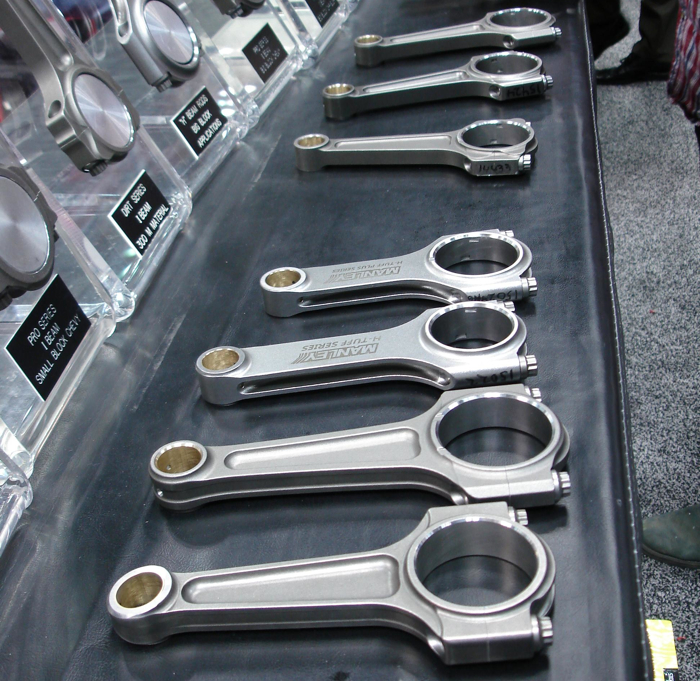
Forged Rods
Most racing rods are made of some type of forged steel, billet steel, forged aluminum or billet aluminum. For those with really deep pockets, there are also super lightweight titanium rods. Commonly used steel alloys include 4140, 4340, 300M and various proprietary steel alloys.
One of the misconceptions about forged steel rods is that these rods are all the same. That’s certainly a marketing claim made by some low cost forged rod suppliers, but the reality is far from it. All forged rods are NOT the same – even if using the same or similar alloys. The differences are in the base alloy (4340 is stronger than 4140), heat treatments and surface finishes. A higher quality (and higher priced) rod will typically have a superior heat treatment that improves tensile and yield strength over a less expensive rod. Likewise, a higher quality (and higher priced) forged rod will usually have a better surface finish that reduces the risk of stress fractures and rod failure.
Various heat treatments can be used to stress relieve and harden connecting rods. Some produce a deeper case hardened layer than others. The goal is to harden the surface without going too deep and making the rod brittle. Shot peening the surface of the rod can relieve stress while work hardening the outer layer of metal, while certain types of heat treatments can diffuse nitrogen deep into the metal for an even stronger and more durable finish. Various micro-polishing treatments can also enhance a rod’s durability while leaving a great-looking finish that sheds oil.
The design of the rod also has a significant impact on its strength, durability and resistance to fatigue failure. I-Beam rods offer a good combination of light weight and strength for high revving engines. A-beam and X-beam variants of the basic I-beam design add metal where it is needed to improve strength. The A-beam is wider towards the big end of the rod to add strength, while the X-beam adds a cross brace down the length of the rod shaft to improve rigidity and strength.
H-beam rods are another option. H-beams have two broad sides that run the length of the rod to handle higher compressive loads. H-beam rods are often recommended for high horsepower, turbocharged, supercharged or nitrous boosted engines. H-beam rods are typically heavier than I-beam rods, and the wider design increases crankcase windage compared to many I-beam rods. Some H-beam rod manufacturers drill a hole just above the big end of the rod to reduce rod weight.
Although opinions often differ, the general consensus is that I-beam rods are better for high revving engines while H-beams are better for boosted high torque motors. Many rod suppliers offer both types of rods while some only produce one or the other.
Brand Loyalty
Reputation and brand recognition play a big role in rod selection. There are a lot of suppliers who offer good quality rods, so how do you choose one brand over another? Sometimes the choice depends on availability, sometimes on price, sometimes on previous experience with a particular supplier and sometimes on what the competition is using in their engines.
Most engine builders are extremely brand loyal and will usually buy their rods from the same supplier – especially if they’ve always had good results with a particular rod supplier’s products. But sometimes they’ll try a different supplier. The reason may be availability (or lack thereof), a lower price, a problem with the product itself or poor customer service. Most rod suppliers will do everything they can to keep their engine builder customers happy, but sometimes they drop the ball or shrug off a problem without resolving it satisfactorily. When that happens, it’s often reason enough to shop elsewhere for parts.
Like we said earlier, there are a lot of good suppliers out there who are anxious for your business whether it is off-the-shelf rods or custom made rods. The one reason that should NOT influence your decision to change suppliers is price. Many rod suppliers today use Chinese forgings because of the low cost. Some forgings are finished and ready to go, but many are brought here and final machined to specifications by the rod supplier. This gives them better quality control over the final product.
Chinese forgings have gotten a bad rap (literally) because some forgings have poor metallurgy and minimal quality control. On the other hand, there are also very good Chinese forgings that conform to ASTM metallurgy standards and are made using QS9000 quality standards. So suppliers who want to maintain brand reputation make sure the Chinese forgings bought are from top-quality sources.
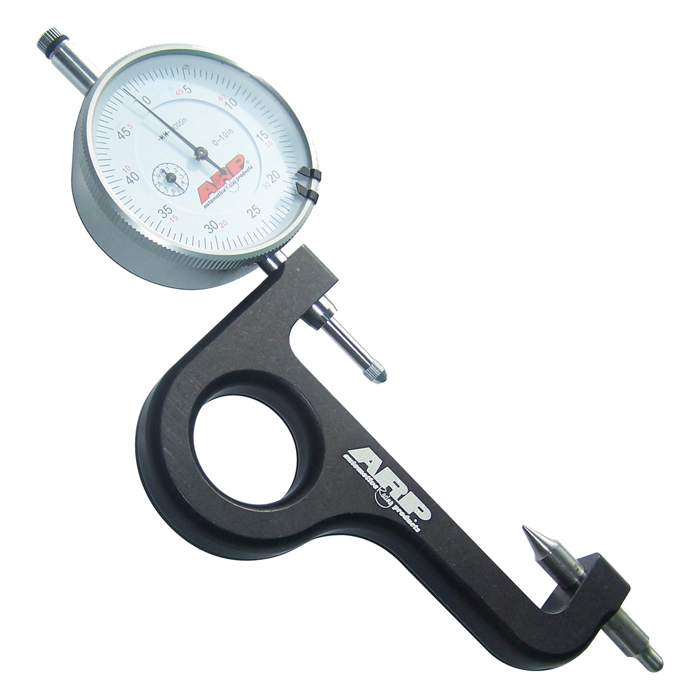
Aluminum Rods
Aluminum rods are a lightweight alternative to steel rods. Thanks to a reduced weight, aluminum rods can rev faster and provide crisper throttle response than heavier steel rods. To achieve the same strength as steel, aluminum rods tend to be thicker. A typical 5.7-inch Chevy small block stock steel rod might weigh around 600 grams compared to 445 to 530 grams for a comparable aluminum rod depending on the alloy used. Rod weights will vary depending on the thickness of the rod, cross-section and length, but are generally much lighter than steel rods. That’s why aluminum rods are used in Top Fuel, Pro Stock and other classes of professional drag racing. Aluminum rod use in circle track motors, on the other hand, is often limited by rules. And for street performance applications, aluminum rods are relatively rare, which brings up yet another myth.
One of the properties of aluminum rods is the ability to stretch more than steel rods when hot. Consequently, you have to allow additional deck clearance when fitting aluminum rods into a performance motor. Several aluminum rod suppliers recommend a minimum piston-to-head clearance of .060˝ to accommodate thermal expansion. Some aluminum rods are also made .010˝ shorter for this reason. Side clearances of aluminum rods also need to be opened up a bit (.002 to .005˝) for added oil clearance.
Because aluminum rods expand more than steel when they get hot, there is a myth that aluminum rods also stretch with use. That’s true with some alloys. The rods may only last 15,000 to 20,000 miles on the street. But with higher quality 7075 T6 heat-treated aluminum or other “aerospace” grade alloys, some aluminum rod suppliers claim these rods are just as durable as steel rods.
In a Top Fuel drag motor, a set of aluminum rods may only last 8 to 10 runs because of the extreme loads that are placed on them. In a Pro Stock motor or alcohol drag motor, the lifespan may be hundreds of runs – even when the engines are revved to 11,000 RPM. So a street application is much less demanding than any drag motor. The question is do you really need aluminum rods in an engine that probably spends most of its time idling or cruising at 2,500 RPM? For the occasional burst of speed, aluminum rods are great. But for the typical street performance application, aluminum is overkill and an unnecessary expense. A good set of powder metal aftermarket performance rods or forged steel I-beam rods will work fine and cost less.
Aluminum rods can be forged or cut from billet. Another myth is that all billet aluminum rods are the same. This is false. A rod that is CNC-machined from a flat piece of cast aluminum plate will not have the grain structure or strength of a rod that is CNC-machined from a hot forged chunk of extruded aluminum. The extrusion process produces a better grain structure than a casting.
Titanium Rods
Titanium rods are the ultimate in lightness. Titanium rods weigh about 30 percent less than steel rods and as a result are very responsive and allow higher RPMs with reduced reciprocal loading on the crank. Titanium rods are used in a lot of exotic engines as well as Formula 1. Titanium, however, is a tougher metal to machine. It’s also more expensive due to the higher market price of the raw metal. A set of titanium rods can cost four to five times as much as a set of steel racing rods.
Another issue with titanium is the tendency for the rod cap to fret. Therefore, the rods are often coated with chromium nitride to reduce wear on the big end thrust surfaces. Fatigue life can also be a concern in racing applications, so rods may be replaced after 40 to 60 hours of racing.
Rod Bolts
One item that’s just as critical as the connecting rods themselves is the bolts that hold the rod together. Stock rod bolts are designed for stock applications and stock loads. So if the engine is being modified to produce more power and/or more RPMs, it will need stronger rod bolts. Various grades of aftermarket rod bolts are available, with increasingly stronger strength ratings.
Rod failures can occur for any of several reasons. One of the most common causes is that the stock rod bolts are not strong enough to hold the cap tightly in place at high RPM.
Of course, rods can also fail if the rod bearing is starved for oil and the bearing seizes, or if coolant, oil or fuel hydrolock the cylinder and bend the rod, or if the engine revs so high that the small end of the rod literally pulls itself apart (which typically happens at the top end of the drag strip when the driver lets off the throttle while the engine is at redline). Better rods bolts cannot prevent these types of failure, but can do a better job of keeping the cap in place and keeping the bottom end of the rod round (which lessens the risk of deformation that can result in bearing failure or cap breakage).
The load on the rod bolts grows exponentially with engine speed. To reduce the stress on the bolt, most performance rods do not use a nut, but thread the rod bolt directly into the upper half of the rod. This provides more thread area to grip the bolt as well as spreads the load over a wider surface. Aftermarket performance rod bolts have a reduced diameter shank so the threads can fully engage the rod. The threads are also cold rolled after the bolt has been heat-treated, which reduces stress that could lead to fatigue cracking. The bolts also have a multi-point head rather than a standard hex head to handle more torque load without damaging the head.
The technique used to install aftermarket performance rod bolts is also different than standard head bolts. With stock bolts, the usual procedure is to lubricate with engine oil and tighten to a certain torque value. If the bolts are the torque-to-yield (TTY) variety, these are given a final twist to a specified angle to achieve the desired load.
The problem with these traditional installation procedures is inconsistent torque and inadequate loading. Roughly half the effort applied to a torque wrench while tightening a fastener is to overcome friction in the threads. Using a lubricant such as oil, grease or a special thread assembly lube reduces friction and increases the load on the fastener, but it can be unreliable because you don’t know exactly how much torque is actually being applied to the fastener. Some assembly lubes are capable of delivering much more consistent results than moly grease or oil, but you still don’t know for sure if you have enough load on the bolt or not.
The best way to tighten rod bolts, therefore, is NOT to depend on torque wrench readings alone, but to measure rod bolt stretch after the bolts have been tightened. This requires using a rod bolt stretch gauge to measure bolt length before and after the bolts have been tightened. If the amount of stretch is .005 to .007˝ (which will vary with the size of the rod and part number), the load on the rod bolt is usually sufficient to hold the rod together under high loads and speeds. You should always refer to the rod bolt supplier’s torque and stretch specifications to determine the correct loading on the bolts.
One last comment on measuring bolt stretch is that some performance rods are “clearanced” for stroker applications by grinding down the shoulders on the big end of the rod. If this extends into the area where the bolt threads into the rod, the end of the bolt may have to be angle cut or ground shorter. You can still measure stretch if the rod bolt is shorter, but there’s no way to measure stretch if the end of the bolt has been angle cut.

